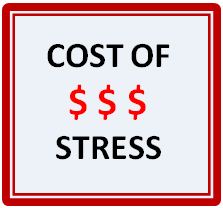There are guaranteed to be significant costs absorbed by your organization when your people are stressed. One of the results of being stressed, or feeling underappreciated, is low engagement. Another is disruption, which occurs in many forms. These culture impacts have predictable and measurable costs. The question is how much cost.
In the attached matrix we start with the engagement levels, on average, for any company that is experiencing a normal working environment. As prolonged periods of stress occur the cost matrix will be impacted by how much the increased stress has further decreased engagement. As these impacts will be unique to each organization we will focus on the baseline that many studies have established for operation in times of normal environmental stressors.
Studies have shown that an average 9% of your payroll cost is lost due to low engagement. That’s a lot of lost profit, not to mention lost opportunity, and this is measured in so called normal times. In unusually, or prolonged, stressful times the risks of employee engagement impacts clearly increase. For an abundance of data supporting these assertions you can simply search “employee engagement cost” in any browser and select the reporting that best suits you. We have expressed the low average calculations in this cost matrix.
So what can we do about these costs? Well, we can first recognize that soft skills, which are in fact stress and culture management skills, offer the best mitigation strategy for dealing with prolonged periods of environmental stressors. The critical conclusion is this. Developing soft skills is not a cost, it’s an investment. It’s an investment with real world measurable impacts on profit.
The left side of the cost matrix represents the average impact of engagement on earned versus paid compensation per 100k of employee cost. This leads to a theoretical cost of low engagement. The right side of the matrix represents the average percentage of employees at each of the engagement levels. This leads to a much more accurate cost of low engagement.
Whether you choose to partner with us or another provider we strongly recommend making soft skills development an important part of your strategic planning. The known bottom line benefits are more than enough to justify your investment. The less easily measured opportunity and competitive advantage benefits will serve to increase the value proposition even more.
If you enjoyed this blog please link to our social media pages, hit the like button and follow us for more interesting and insightful looks into what it takes to build a results oriented communication culture.


